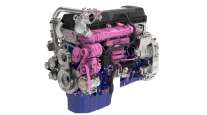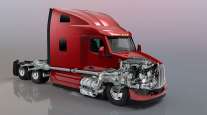Staff Reporter
California Deploys Portable Emissions Detectors Ahead of New Smog Rules

[Stay on top of transportation news: Get TTNews in your inbox.]
California is deploying a portable emissions detector in areas with heavy truck traffic to educate drivers and operators about a new smog check program that starts Jan. 1.
The Heavy-Duty Inspection and Maintenance Program is being phased in starting next year by the California Air Resources Board, which calls it “a groundbreaking smog check program” to help ensure the 1 million heavy-duty trucks operating there “run clean for the life of the vehicle.”
In a series of enforcement events, CARB has been deploying its Portable Emissions Acquisition System (PEAQs) that screens for high emissions as heavy trucks drive underneath it.
#CARBEnforcement deployed the Portable Emissions Acquisition System (PEAQs) – the ‘dirty truck detector’ – today @PortofOakland to identify high-emitting trucks.
https://t.co/07cfmu0Dlv#publichealth #cleantrucks pic.twitter.com/0iLiu0M8wm — CARB (@AirResources) October 25, 2022
High-emitting vehicles are flagged for full inspections, including a smoke test and verification of emissions-control equipment to determine if repairs are needed. Citations can be issued during the screenings.
CARB unveiled what it called the “Dirty Truck Detector” Aug. 23 near the Port of Los Angeles during a five-hour event attended by CARB Board Member Gideon Kracov as well as CARB air pollution specialists and technicians.
More than 1,200 trucks were screened in CARB’s bid to alert truck owners and operators about new “smog check” requirements for heavy-duty vehicles and the phase-in timeline.
The latest screening was conducted for three hours Nov. 1 at the Calexico border crossing on the U.S. side (a heavily traveled truck route for trade with Mexico).
“CARB has several unattended PEAQs systems deployed in the state as well as the mobile PEAQs units, like the one used in Calexico, for use in specific areas. The cost savings from the public health benefits (deaths, hospitalizations, etc., from air quality-induced illness) far outweighs the cost of the monitoring systems,” Lynda Lambert, CARB spokesperson, told Transport Topics.

A truck is inspected at Oakland. (CARB)
In Oakland, of 281 trucks screened Oct. 25, 15 were identified as higher-emitting and selected for full inspection.
“This [Oakland event] demonstrates the value of using a screening tool like PEAQS so that only the higher emitting vehicles are selected for inspection,” Lambert said.
Another pop-up inspection was held Oct. 18 in San Diego at a California Highway Patrol facility at the commercial border crossing at Otay Mesa.
“While CARB doesn’t disclose information on future enforcement events, the use of PEAQs and roadside checks are a key component to upholding California’s air quality regulations. PEAQs works in conjunction with the smog check program to identify vehicles that have high emissions between periodic testing,” Lambert said.
The Heavy-Duty Inspection and Maintenance Program will apply to all heavy-duty trucks, buses and agricultural equipment with a gross vehicle weight rating over 14,000 pounds traveling in the state regardless of whether they are registered in California.
The second phase begins in mid-2023 by requiring all heavy-duty trucks to register with CARB and obtain a certificate of compliance to operate in the state.
In the 2024 final phase, registration of heavy-duty trucks in California will require proof of emissions compliance with the program and emissions inspections must be done twice a year for vehicles with onboard diagnostic (OBD) systems, increasing to four times per year testing in 2027.
CARB estimates 75% to 80% of all heavy-duty trucks will have OBD equipment with telematics technology to send the data automatically when the program begins.
Want more news? Listen to today's daily briefing above or go here for more info
Older heavy-duty vehicles without OBD systems will continue the current opacity testing requirements with an added visual testing component, twice annually.
Lambert pointed out that heavy-duty vehicle owners will be able to complete the required program test and deliver emissions systems inspection information remotely “without having to travel to designated testing locations.”
She said, “The test can be carried out conveniently using your truck’s OBD connector at home or place of business provided it’s performed by a CARB-credentialed tester using a CARB-certified readout device. The program keeps trucks operating at maximum efficiency, saving fuel and other costs.”




